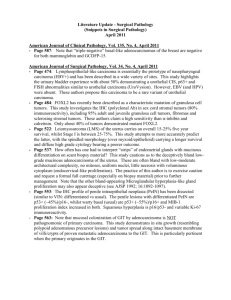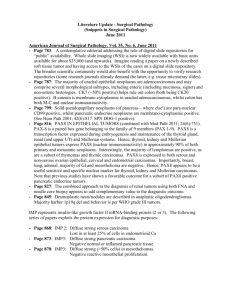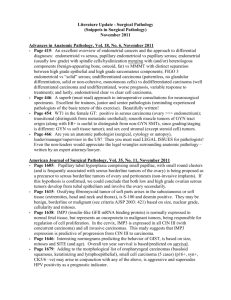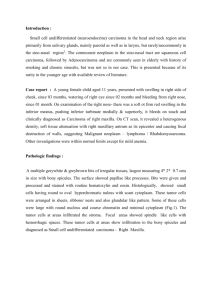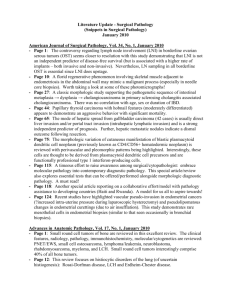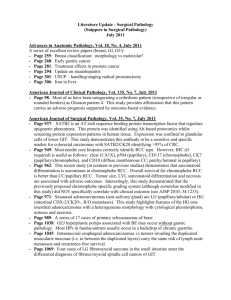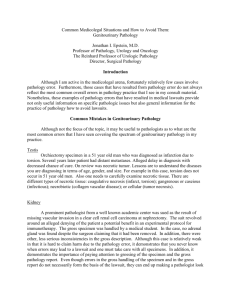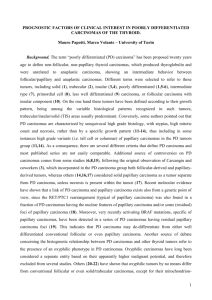Literature Update - Surgical Pathology
advertisement
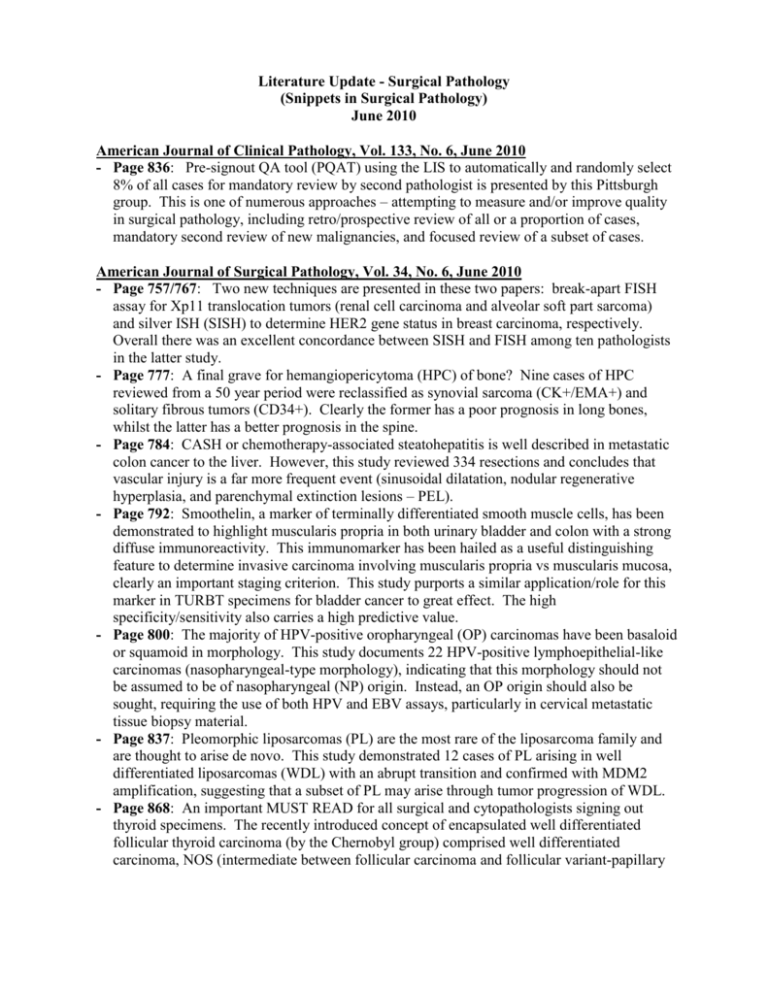
Literature Update - Surgical Pathology (Snippets in Surgical Pathology) June 2010 American Journal of Clinical Pathology, Vol. 133, No. 6, June 2010 - Page 836: Pre-signout QA tool (PQAT) using the LIS to automatically and randomly select 8% of all cases for mandatory review by second pathologist is presented by this Pittsburgh group. This is one of numerous approaches – attempting to measure and/or improve quality in surgical pathology, including retro/prospective review of all or a proportion of cases, mandatory second review of new malignancies, and focused review of a subset of cases. American Journal of Surgical Pathology, Vol. 34, No. 6, June 2010 - Page 757/767: Two new techniques are presented in these two papers: break-apart FISH assay for Xp11 translocation tumors (renal cell carcinoma and alveolar soft part sarcoma) and silver ISH (SISH) to determine HER2 gene status in breast carcinoma, respectively. Overall there was an excellent concordance between SISH and FISH among ten pathologists in the latter study. - Page 777: A final grave for hemangiopericytoma (HPC) of bone? Nine cases of HPC reviewed from a 50 year period were reclassified as synovial sarcoma (CK+/EMA+) and solitary fibrous tumors (CD34+). Clearly the former has a poor prognosis in long bones, whilst the latter has a better prognosis in the spine. - Page 784: CASH or chemotherapy-associated steatohepatitis is well described in metastatic colon cancer to the liver. However, this study reviewed 334 resections and concludes that vascular injury is a far more frequent event (sinusoidal dilatation, nodular regenerative hyperplasia, and parenchymal extinction lesions – PEL). - Page 792: Smoothelin, a marker of terminally differentiated smooth muscle cells, has been demonstrated to highlight muscularis propria in both urinary bladder and colon with a strong diffuse immunoreactivity. This immunomarker has been hailed as a useful distinguishing feature to determine invasive carcinoma involving muscularis propria vs muscularis mucosa, clearly an important staging criterion. This study purports a similar application/role for this marker in TURBT specimens for bladder cancer to great effect. The high specificity/sensitivity also carries a high predictive value. - Page 800: The majority of HPV-positive oropharyngeal (OP) carcinomas have been basaloid or squamoid in morphology. This study documents 22 HPV-positive lymphoepithelial-like carcinomas (nasopharyngeal-type morphology), indicating that this morphology should not be assumed to be of nasopharyngeal (NP) origin. Instead, an OP origin should also be sought, requiring the use of both HPV and EBV assays, particularly in cervical metastatic tissue biopsy material. - Page 837: Pleomorphic liposarcomas (PL) are the most rare of the liposarcoma family and are thought to arise de novo. This study demonstrated 12 cases of PL arising in well differentiated liposarcomas (WDL) with an abrupt transition and confirmed with MDM2 amplification, suggesting that a subset of PL may arise through tumor progression of WDL. - Page 868: An important MUST READ for all surgical and cytopathologists signing out thyroid specimens. The recently introduced concept of encapsulated well differentiated follicular thyroid carcinoma (by the Chernobyl group) comprised well differentiated carcinoma, NOS (intermediate between follicular carcinoma and follicular variant-papillary thyroid carcinoma) and well differentiated follicular tumor of UMP (either incomplete PTCtype nuclei and/or incomplete capsular invasion). In a review of 1039 thyroid carcinomas over a 12 year follow-up, this study showed that of the 102 encapsulated well differentiated follicular carcinomas (either minimal capsular invasion or PTC-nuclei), none died as a result of the latter diagnosis, confirming an extremely favorable outcome for these tumors. Archives of Pathology and Laboratory Medicine, Vol. 134, No. 6, June 2010 Another in the series of controversies in pathology presents a set of challenging diagnostic issues in GI pathology: - Page 815: EE vs GERD - Page 826: Celiac disease - Page 864: Appendiceal mucinous neoplasms - Page 871: Endocrine tumors of appendix - Page 876: Colorectal dysplasia in IBD - Page 907: The CAP recommendations for IHC testing for ER/PR in breast cancers Histopathology, Vol. 56, No. 7, June 2010 - Page 835: The role of the surgical pathologist in the assessment of parathyroid glands is reviewed, addressing new trends/approaches to parathyroid disease. - Page 951: Smoothelin IHC is again presented as a useful adjunct to assess muscularis propria invasion in bladder carcinoma (TURBT – transurethral resection of bladder tumor). - Page 957: Note that p16 overexpression is frequently detected in tumor-free tonsil without associated HPV, supporting the role for concurrent HPV detection. Human Pathology, Vol. 41, No. 6, June 2010 - Page 781: Multifocal prostate carcinoma now requires accurate grading/staging presenting with a unique set of difficulties to the histopathologist. This paper applauds the improvements but questions the clinical significant of T2 substaging. - Page 832: A cohort of mediastinal germ cell tumors with an angiosarcomatous component is presented, reminding us to think about germ cell tumors when confronted with a malignant soft tissue tumor on a needle core biopsy of a mediastinal mass. Other tumors include rhabdomyosarcoma, leiomyosarcoma and carcinoma. Clearly these tumors overall have a poor outcome. Journal of Clinical Pathology, Vol. 63, No. 6, June 2010 - Page 488: An excellent (and unique) review of familial paraganglioma syndromes. Morphologically similar to sporadic tumors, awareness of potential syndromes in this setting (MEN2, VHL, NFI, paraganglioma syndromes, Carney’s). Multiple paragangliomas is a useful hint (and sclerosing varieties, in my experience) that one is dealing with a syndromic tumor. - Page 492: The NUT midline carcinomas have been frequently reviewed recently in these missives. The molecular pathology is reviewed in this paper: (t15;19) and the NUT gene (nuclear protein in testis). These are poorly differentiated carcinomas with a hint of variable squamous differentiation presenting in the head/neck and mediastinum of children and young adults. Based on the latter, a high index of suspicion is warranted with NUT rearrangements confirmed by FISH or RTPCR. These tumors are rare and many cases probably go unrecognized. Modern Pathology, Vol. 23, No. 6, June 2010 - Page 781: The concept of an undifferentiated carcinoma in the endometrium and ovary (AKA dedifferentiated carcinoma) was first introduced by the MD Anderson group. The present study reviews 26 endometrial and 6 ovarian carcinomas with an undifferentiated component (either entirely undifferentiated or a combination with endometrioid adenocarcinoma). The undifferentiated monotonous cytologic appearance of sheets of dyshesive, ovoid cells (uniform large vesicular nuclei) may frequently be misdiagnosed as carcinosarcoma, undifferentiated high-grade sarcoma, neuroendocrine carcinoma, lymphoma, granulosa cell tumor or epithelioid sarcoma (variable zones of rhabdoid morphology). The strong (but focal) keratin (esp CK18) and EMA is helpful in the diagnosis of undifferentiated carcinoma. Approximately 50% show abnormal MMR protein expression (indicative of MSI). These tumors, according to the authors, should be accurately diagnosed since they behave aggressively. - Page 834: Foveolar type dysplasia in Barrett esophagus (as opposed to intestinal differentiation of the adenomatous type) is suggestive of a non-intestinal pathology in BE: gastric metaplasia → foveolar dysplasia → adenocarcinoma. Kumarasen Cooper, MBChB Department of Pathology University of Vermont Burlington, Vermont 05401 E-mail address: Kum.Cooper@vtmednet.org
